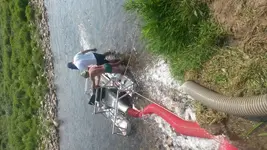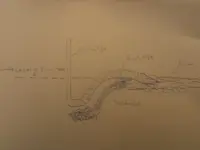spaghettigold
Hero Member
- Joined
- Oct 14, 2013
- Messages
- 566
- Reaction score
- 785
- Golden Thread
- 0
- Location
- western sahara
- Primary Interest:
- All Treasure Hunting
- #1
Thread Owner
hi all
In many places where i like to dredge there,s not enough drop to gravity dredge,Sometimes i can correct that by building dams but when there,s not enough natural drop on the spot to begin with,the dams must be build high ,which then creates a deep pool where i want to dredge .Since i ,m not allowed to use motors i can,t use compressors for diving,deep pools are a limiting factor.
I was thinking to build a maybe 2 feet high dam where i want to dredge to have a basic suction and then build a second higher dam somewhere else ,where i can get 6 feet drop to feed a power jet . Will this slightly increase my suction in the already with 2 feet drop working 8 inch suction hose to a good point? Should the hose that feeds the power jet have a certain diameter? Is bigger better?
In many places where i like to dredge there,s not enough drop to gravity dredge,Sometimes i can correct that by building dams but when there,s not enough natural drop on the spot to begin with,the dams must be build high ,which then creates a deep pool where i want to dredge .Since i ,m not allowed to use motors i can,t use compressors for diving,deep pools are a limiting factor.
I was thinking to build a maybe 2 feet high dam where i want to dredge to have a basic suction and then build a second higher dam somewhere else ,where i can get 6 feet drop to feed a power jet . Will this slightly increase my suction in the already with 2 feet drop working 8 inch suction hose to a good point? Should the hose that feeds the power jet have a certain diameter? Is bigger better?
Attachments
Last edited:





 ) prospectors chime in
) prospectors chime in  ... it is possible to use water head/ PSI to increase itself and drive to a greater height ... a hydraulic ram pump being the example, but this delivers a tiny fraction of the volume required to drive it and so it will increase PSI but no GPM which a venturi requires both ....
... it is possible to use water head/ PSI to increase itself and drive to a greater height ... a hydraulic ram pump being the example, but this delivers a tiny fraction of the volume required to drive it and so it will increase PSI but no GPM which a venturi requires both ....

 and so it pays to help in every way
and so it pays to help in every way 



